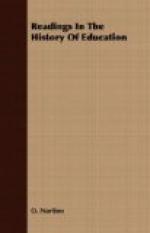The scholastic fever, which was soon to inflame the youth of the whole of Europe, had already set in. You could not travel far over the rough roads of France without meeting some footsore scholar, making for the nearest large monastery or cathedral town. Before many years, it is true, there arose an elaborate system of conveyance from town to town, an organization of messengers to run between the chateau and the school; but in the earlier days, and, to some extent, even later, the scholar wandered afoot through the long provinces of France. Robbers, frequently in the service of the lord of the land, infested every province. It was safest to don the coarse frieze tunic of the pilgrim, without pockets, sling your little wax tablets and stylus at your girdle, strap a wallet of bread and herbs and salt on your back, and laugh at the nervous folk who peeped out from their coaches over a hedge of pikes and daggers. Few monasteries refused a meal or a rough bed to the wandering scholar. Rarely was any fee exacted for the lesson given. For the rest, none were too proud to earn a few sous by sweeping, or drawing water, or amusing with a tune on the reed-flute; or to wear the cast-off tunics of their masters.[1]
This account refers to the study of logic and theology, which soon became dominant in Paris and in various cathedral schools in other parts of France. With slight modifications it would describe also the revival of interest in Roman law in Italy, especially at Bologna.
2. The revival was concerned mainly with professional, or—as later appeared—university, education. The prevailing interest was in Law, Medicine, Theology, and the philosophy of Aristotle. Schools of lower grade were much influenced by the intellectual activity of the times, but the characteristic product of this movement was the university. The universities, organized as corporations, with their teachers divided into faculties, their definite courses of study, their examinations, their degrees, their privileges, and their cosmopolitan communities of students, were not only the result of the revival, but they were institutions essentially new in the history of education, and the models for all universities which have since been established.
3. Between the latter part of the twelfth century and 1500 A.D. at least seventy-nine universities were established in western Europe. There may have been others of which no trace remains. Several of them were short-lived, some lasting but a few years; ten disappeared before 1500. Since that date twenty others have become extinct. The forty-nine European universities of to-day which were founded before 1500 have all passed through many changes in character and various periods of prosperity and decline, but we still recognize in them the characteristic features mentioned above, and the same features reappear in the “most modern, most practical, most unpicturesque of the institutions which now bear the name of ‘University.’” This is one illustration of the statement on page 2 that the daily and hourly conduct of university affairs in the twentieth century is to a surprising degree influenced by what universities did seven centuries ago.




